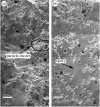A new self-healing epoxy with tungsten (VI) chloride catalyst
- PMID: 17580292
- PMCID: PMC2605505
- DOI: 10.1098/rsif.2007.1071
A new self-healing epoxy with tungsten (VI) chloride catalyst
Abstract
Using self-healing materials in commercial applications requires healing chemistry that is cost-effective, widely available and tolerant of moderate temperature excursions. We investigate the use of tungsten (VI) chloride as a catalyst precursor for the ring-opening metathesis polymerization of exo-dicyclopentadiene (exo-DCPD) in self-healing applications as a means to achieve these goals. The environmental stability of WCl6 using three different delivery methods was evaluated and the associated healing performance was assessed following fracture toughness recovery protocols. Both as-received and recrystallized forms of the WCl6 resulted in nearly complete fracture recovery in self-activated tests, where healing agent is manually injected into the crack plane, at 12wt% WCl6 loading. In situ healing using 15wt% microcapsules of the exo-DCPD produced healing efficiencies of approximately 20%.
Figures









References
-
- Balcar H, Dosedlová A, Petrusová L. Ring-opening metathesis polymerization of dicyclopentadiene by unicomponent catalysts derived from WCl6. J. Mol. Catalysis. 1992;77:289–295. doi: 10.1016/0304-5102(92)80208-X. - DOI
-
- Breslow D.S. How we made neat stuff. Chemtech. 1990;20:540–544.
-
- Brown E.N, Sottos N.R, White S.R. Fracture testing of a self-healing polymer composite. Exp. Mech. 2002;42:372–379. doi: 10.1177/001448502321548193. - DOI
-
- Brown E.N, White S.R, Sottos N.R. Microcapsule induced toughening in a self-healing polymer composite. J. Mater. Sci. 2004;35:1703–1710. doi: 10.1023/B:JMSC.0000016173.73733.dc. - DOI
Publication types
MeSH terms
Substances
LinkOut - more resources
Full Text Sources
Other Literature Sources
